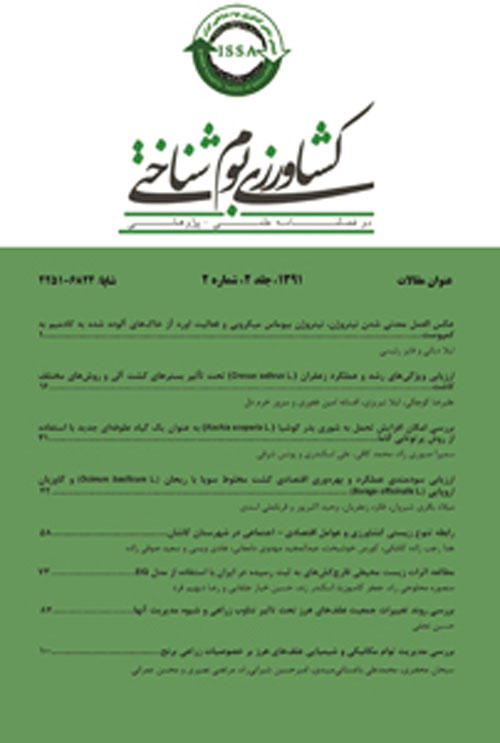Effect of biodiversity on economic yield and weed population regulation in corn, soybean and marshmallow intercropping
Author(s):
Abstract:
Introduction
Increasing crop diversity through intercropping can be effective to improve the functions and ecosystem services. One of the main functions of multiple cropping systems is weed control and increasing yield crop (Bulson et al.¡ 1997). To study the effects of intercropping on yields of corn¡ soybean and marshmallow¡ land equivalent ratio (LER) and the control potential of weeds¡ experimental research was carried out at the farm of Ferdowsi University of Mashhad in the growing season of 2013-2014.Materials And Methods
Experimental research was carried out as strip split plot based on randomized complete block design at the farm of Ferdowsi University of Mashhad in the growing season of 2013-2014. Experimental treatments (14 treatments) included weed factor at 2 levels and also different planting patterns of intercropping of corn¡ soybean and marshmallow at 7 levels with 3 replicates. The studied characteristics included yield¡ land equivalent ratio (LER)¡ density and dry matter of weeds.Results And Discussion
The highest density of weeds between the different patterns of intercropping was obtained from sole cropping of soybean (46.7 plants per m2) and the lowest density of weeds was obtained from intercropping of corn¡ soybean and marshmallow (37.6 plants per m2). The greatest reduction percentage of corn yield in the presence of weeds was achieved from sole cropping of corn (22.7%) and also the least reduction percentage of corn yield in the presence of weeds was achieved from intercropping of corn¡ soybean and marshmallow (15.6%). The greatest and the least reduction percentages of soybean yield in the presence of weeds were obtained from sole cropping of soybean (32.3%) and intercropping of corn¡ soybean and marshmallow (19.1%)¡ respectively. Also¡ the greatest and the least reduction percentages of marshmallow yield in the presence of weeds were obtained from sole cropping of marshmallow (36.4%) and intercropping of corn¡ soybean and marshmallow (23.6%)¡ respectively. The results showed that different patterns of intercropping had higher yield compared to sole cropping. In weed control conditions¡ the highest amount of land equivalent ratio was obtained from intercropping maize and soybean (1.083). In the presence of weeds¡ the greatest and the least land equivalent ratios were achieved from intercropping of corn¡ soybean and marshmallow (1.246) and the intercropping of soybean and marshmallow (1.093)¡ respectively. Investigation of the land equivalent ratio showed that intercropping of maize¡ soybean and marshmallow was superior to sole cropping of them. Higher amounts of LER in the presence of weeds compared to the absence of weeds shows the beneficial effects of intercropping in weeds control and yield enhancement compared to sole cropping.Conclusion
The results showed that the land equivalent ratio was higher than one in all different patterns of intercropping¡ Indicating the superiority of intercropping compared to the sole cropping of corn¡ soybean and marshmallow in terms of economic yield. In total¡ the results showed that intercropping of these species can produce higher yield due to better control of weeds. Keywords:
Language:
Persian
Published:
Journal of Agroecology, Volume:6 Issue: 1, 2016
Page:
182
magiran.com/p1586542
دانلود و مطالعه متن این مقاله با یکی از روشهای زیر امکان پذیر است:
اشتراک شخصی
با عضویت و پرداخت آنلاین حق اشتراک یکساله به مبلغ 1,390,000ريال میتوانید 70 عنوان مطلب دانلود کنید!
اشتراک سازمانی
به کتابخانه دانشگاه یا محل کار خود پیشنهاد کنید تا اشتراک سازمانی این پایگاه را برای دسترسی نامحدود همه کاربران به متن مطالب تهیه نمایند!
توجه!
- حق عضویت دریافتی صرف حمایت از نشریات عضو و نگهداری، تکمیل و توسعه مگیران میشود.
- پرداخت حق اشتراک و دانلود مقالات اجازه بازنشر آن در سایر رسانههای چاپی و دیجیتال را به کاربر نمیدهد.
In order to view content subscription is required
Personal subscription
Subscribe magiran.com for 70 € euros via PayPal and download 70 articles during a year.
Organization subscription
Please contact us to subscribe your university or library for unlimited access!


